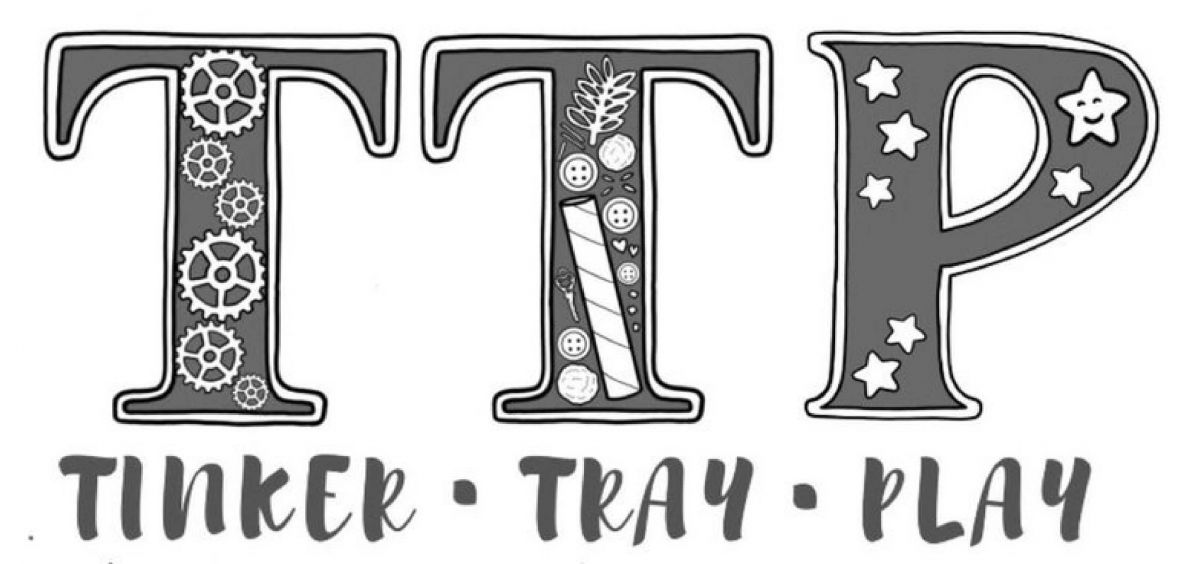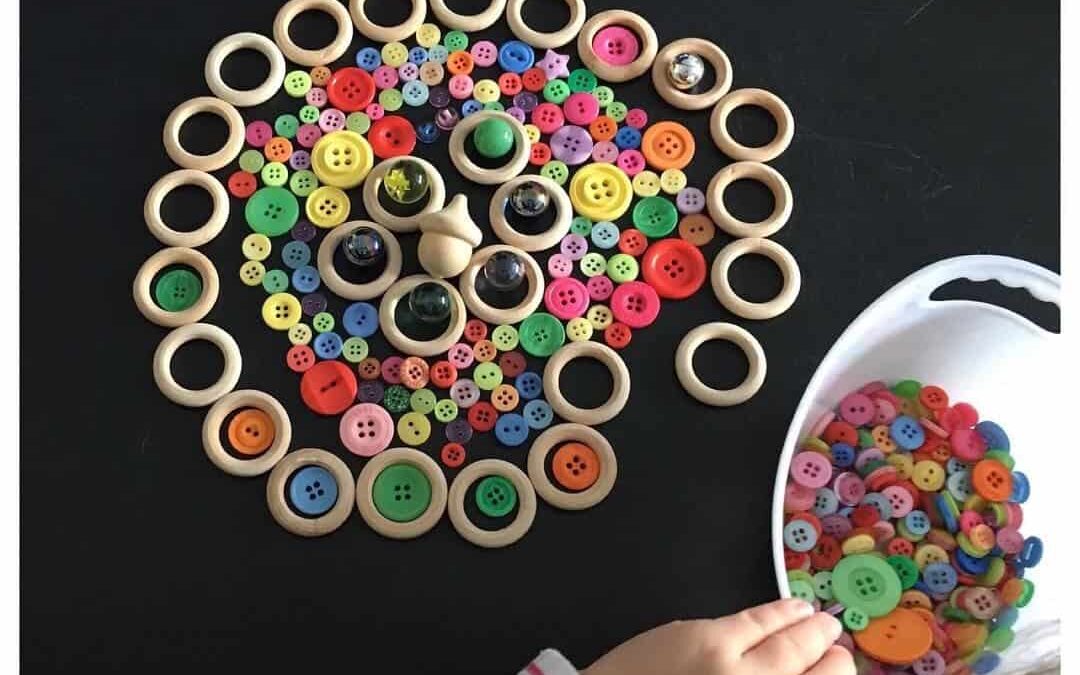
Written for, and published by The Professional Association for Childcare and Early Years (PACEY).
Anna Welch, owner of Tinker Tray Play, 26th March 2019.
Children will tinker for hours with obscure objects; a tin of mixed buttons, a box of empty jars and their lids, a pile of pebbles in the garden. Ask any parent or practitioner and they’ll confirm the age old cliche of the cardboard box attracting more attention than its contents. What each of these items has in common is a lack of restriction. With no prescribed method of play, items can be used entirely at the discretion of the child. Children can explore, create and imagine in all the senses of those words and assign their own purpose and meaning to the objects. This type of play is called ‘loose parts play.’
What is the Theory Behind Loose Parts Play?
The pedagogical approach for loose parts is to enable children to undertake their own learning using everyday objects rather than ‘toys’. The concept originates from architect Simon Nicholson who wrote about the benefits of a loose parts environment to child development. The article is an interesting read, and states that “in any environment, both the degree of inventiveness and creativity, and the possibility of discovery, are directly proportional to the number and kind of variables in it.” He identifies loose parts as “all the things that satisfy ones curiosity and give us the pleasure that results from discovery and invention.” Loose parts present variables that support a particular type of experimental play; beneficial because “children learn most readily and easily in a laboratory type environment where they can experiment, enjoy and find out things for themselves.”(1)
How Should Loose Parts be Presented to Children?
In an ideal world, loose parts should be easily accessible to the child, preferably placed at the child’s level where they can be seen and selected freely. I’m a childminding setting and based in a small playroom that’s part of my lounge, so I don’t have this luxury. Instead I rotate our loose part resources. I use a bookshelf with small wooden bins that the children can easily see into and safely select, and I surround these bins with interesting ‘bits and bobs’ that they can take and use. I also have a tiered storage unit full of loose parts. The rest I keep on shelves as visible as possible so the children can see it and ask for it.
Just as an aside, whilst it is best practice for loose parts to be freely available this does of course need to be risk assessed. At my setting I store the smaller items in tinker trays or sealed jars out of the reach of our youngest members. Anything small enough to pose a choking hazard such as glass nuggets, marbles, pompoms to name just a few.
Tinker trays are a fantastic way of presenting loose parts and so simple to make; find a tray and fill it with a selection of resources. I love these for the older children as they can be themed to add an extra touch of magic. We’ve had spring, autumn and winter trays, pirate trays, farm trays – you can create anything you like to suit your setting and teaching style, and Tinker Trays make it easier to contain those smaller loose part pieces that are only for the older age groups. I tend to bring out the tinker trays when we’re sitting at a table playing with clay or playdough.
It’s also fun to give the children empty picture frames and let them create their own transient art.

So What Kind of Things Can Be Used as Loose Parts?
Well the possibilities are endless and really only limited by your imagination. Once you’re in the right mind-set, everything becomes a loose part! The key thing to remember is that materials must be open ended, that is they have no pre-determined rules for use and can be made, moved, moulded, manipulated and morphed into any number of things using only imagination. Some of my favourites are;
- Household items like cotton reels, curtain rings, blocks, beads, buttons, balls, tubes, tins, pots, springs, washers, marbles, bangles, tiles, pegs.
- Natural resources such as stones, sea shells, feathers, pine cones, leaves, sticks, conkers, acorns, sand.
- Fabrics such as scarves, ribbons, laces, scrunchies.
- Modelling materials like playdough, kinetic sand and even slime.
- Plastic and synthetic resources definitely have a place too. Lego, bunchems, stickle bricks, and magnatiles are all regularly used at Little Stars Childminding.
We have more loose parts in our garden; drain pipe cut offs, tyres, wooden planks, bricks, sand, stones, sticks, pine cones, even water is a loose part!
You can see that loose parts are not toys in the traditional sense of the word, they are a collection of ‘things’ that can be moved, merged, collected, shared, taken apart, stacked, stored, built up, lined up and any other type of play that you can think of and as such, they’re a fantastic resource to support schemas in young children’s play!


What Will Children Gain from Loose Parts Play?
There are so many benefits to providing open ended loose part resources. You will be providing children with an enabling environment full of interesting objects that support creativity and invention. Infinite variables ensure constant interest from children and the ability to move, modify or mould play and materials to meet individual requirements means resources are adaptable to all ages and stages of development. Similarly, it’s impossible to use a loose part in the ‘wrong’ way so there is no sense of failure for children. And the reverse, children can gain a huge sense of personal achievement for reaching the goals of their play, plus experience the thrill and achievement of discovery and experimentation. Plus, loose parts are not gendered and have no stereotypes.
As a childminder it’s important to me that my resources support the learning outcomes of the Early Years Foundation Stage. Here’s how loose parts meet each of the seven areas of learning:
- Personal, Social and Emotional Development – Independent play, making choices about what and how to play, sharing resources, playing alongside others.
- Physical Development – Fine and gross motor skills, learning how to lift and carry.
- Communication and Language – Speaking with other children during shared play, new language and vocabulary.
- Mathematics – Concepts such as shape, size, sequencing, sorting, counting, combining and measuring.
- Literacy – Mark making and storytelling narratives during play.
- Understanding the World – Using loose parts during role play; stones in the kitchen, wooden blocks as cars, testing ideas and theories.
- Expressive Arts and Media – Opportunity to explore media and materials, application of loose parts for creativity and art.
So, why not try it? Next time a toy breaks at your setting, replace it with a loose part. Little tip though; it is a good idea to have a simple system for organising things so the children know where to find items and where to put them back. Regardless, you will spend a lot of time tidying up the remnants of play (sounds better than mess right!), but it’s worth it for the learning that’s occurred.
So why do I love tinker trays and loose part play? Because the children love it, because they immerse themselves into their own narratives and imaginary worlds, because they question and test and achieve. I am a firm believer in the power of play. Loose parts and open ended resources enable the child to create and learn in a way that is unique and meaningful to them. It is during this pursuit of individual interest that true learning through play occurs. That’s why I love it!

What are your favourite loose parts? Please share your ideas and any hints or tips for loose parts on a budget are more than welcome!

